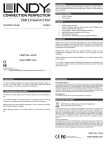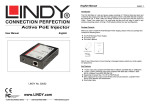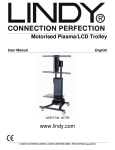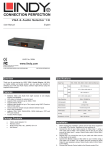Transcript
Introduction Thank you for purchasing the LINDY USB 2.0 AutoSwitch Classic. The LINDY USB 2.0 AutoSwitch Classic is designed to allow you to easily share a USB 2.0 device between two/four computers. Package Contents USB 2.0 AutoSwitch Classic Installation Guide English • • USB 2.0 AutoSwitch Classic This manual Features • • • • • • USB 2.0 device sharing - Backwards compatible with USB 1.1 Hot pluggable - Easily moved between computers Hot key - Quick switching between computers LED Display - Indicates active port Bus Powered – Powered from your computers USB port Compatible with USB computers: PC, Mac Installation Please ensure that all computers and peripherals are switched off before starting the installation. Plug the USB Type A connector (pictured below) of a USB A/B cable (not included) in to the USB port of your computer and the USB Type B connector to the USB Switch. LINDY No. 42795: 2 Port LINDY No. 42784: 4 Port www.LINDY.com Repeat these steps to connect further computers. Once you have completed the installation you may switch on your computers and the peripheral. If you need to share multiple USB devices between your computers you can connect a USB hub to the USB Switch and then connect the USB devices to the hub. For Home and Office Use Tested to Comply with FCC Standards © LINDY ELECTRONICS LIMITED & LINDY-ELEKTRONIK GMBH - FIRST EDITION (OCT 2009) Instructions To switch between computers you can simply press the button on the top of the USB Switch, as you press the button you will see that the LED on the USB Switch will switch accordingly to indicate which computer is currently accessing the USB device. If you are using a computer running a Windows Operating System then you can also switch between computers by pressing the Scroll Lock key twice within two seconds. The LED will then flash to indicate that you are switching control of the USB Switch between computers, when the LED stops flashing it will indicate which computer is in control. Troubleshooting Information The maximum cable length used to connect devices to the USB Switch is 2m. If you need to switch to a computer which is in ‘Sleep’ mode you will need to wake the computer before it is possible to switch to the computer. Always ensure that the attached USB device is not in use before attempting to switch between computers. Never attempt to switch to a computer which is in the process of booting up. Certifications FCC Certifications This equipment has been tested and found to comply with the limits for a Class B Digital device, pursuant to part 15 of the FCC Rules. These limits are designed to provide reasonable protection against harmful interference in a residential installation. This equipment generates, uses, and can radiate radio frequency energy and, if not installed and used in accordance with the instructions. This device complies with Part 15 of the FCC Rules. Operation is subject to the following two conditions: (1) this device may not cause harmful interference, and (2) this device must accept any interference received; including interference that may cause undesired operation. CE Statement This equipment complies with the relevant EC Regulations for IT Equipment Recycling Information WEEE (Waste of Electrical and Electronic Equipment), Recycling of Electronic Products In 2006 the European Union introduced regulations (WEEE) for the collection and recycling of all waste electrical and electronic equipment. The Wheelie bin symbol shown indicates that this product must not be disposed of with household waste. Instead the product must be recycled in a manner that is environmentally friendly. For more information on how to dispose of this product, please contact your local recycling centre or your household waste disposal service. Each individual EU member state has implemented the WEEE regulations into national law in slightly different ways. Please follow your national law when you want to dispose of any electrical or electronic products. Germany / Deutschland Die Europäische Union hat mit der WEEE Direktive umfassende Regelungen für die Verschrottung und das Recycling von Elektro- und Elektronikprodukten geschaffen. Das ElektroG – Elektro- und Elektronikgerätegesetz verbietet das Entsorgen von entsprechenden, auch alten, Elektro- und Elektronikgeräten über die Hausmülltonne! Diese Geräte müssen den lokalen Sammelsystemen bzw. örtlichen Sammelstellen zugeführt werden! Dort werden sie kostenlos entgegen genommen. Die Kosten für den weiteren Recyclingprozess übernehmen die Gerätehersteller. Do not press the Switching Key whilst the LED is flashing, wait for the LED to become stable before pressing the Switching Key again. LINDY No.42795 & 42784 For Home and Office Use Tested to Comply with FCC Standards www.lindy.com




